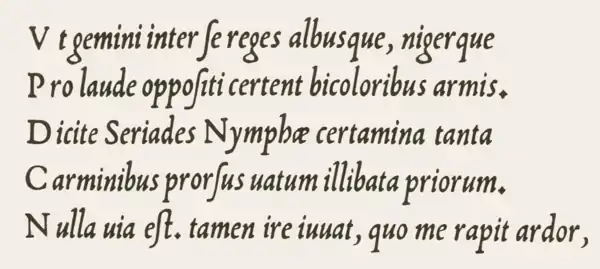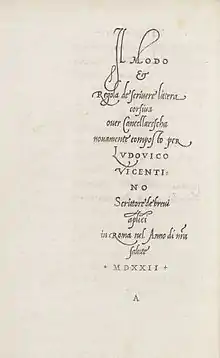Ludovico Vicentino degli Arrighi
Ludovico Vicentino degli Arrighi (1475?–1527?) was a papal scribe and type designer in Renaissance Italy.

Very little is known of the circumstances of his life. He may have started his career as a writing master in Venice, although this has been disputed.[1] Around 1510 he was a bookseller in Rome. He was employed as a scribe at the Apostolic Chancery in 1513. His experience in calligraphy led him to create an influential pamphlet on handwriting in 1522 called La Operina, which was the first book devoted to writing the italic script known as chancery cursive.[2] This work, a 32-page woodblock printing, was the first of several such publications.
He turned to printing in 1524 and designed his own italic typefaces for his work, which were widely emulated. His last printing was dated shortly before the sack of Rome (1527), during which he was probably killed.
His letterforms were revived in the 20th century by designers such as Stanley Morison, Frederic Warde, Robert Slimbach (for example Adobe Jenson italic) and Jonathan Hoefler (in his Requiem Text typeface.) The italic script presented in La Operina was also revived in the 20th century with Alfred Fairbank's book A Handwriting Manual (1932), Getty-Dubay italic script, and the work of Gunnlauger SE Briem.
Works
- Regola da imparare scrivere varii caratteri de littere con li suoi compassi et misure (in Italian). Venezia: Niccolò Zoppino. 1533.
 Regola da imparare scrivere varii caratteri de littere con li suoi compassi et misure, 1533
Regola da imparare scrivere varii caratteri de littere con li suoi compassi et misure, 1533
Notes
- Ogg, Oscar (1953). Three Classics of Italian Calligraphy. Dover Publications. p. 253. ISBN 978-0-486-20212-9.
- Lawson, Alexander S. (1990). Anatomy of a Typeface. David R. Godine. p. 84. ISBN 978-0-87923-332-7.
External links
- Free downloadable copy of the book with English translation as zipped .pdf
- Identifont biography.
- Specimen sheet.
- Requiem typeface
- Commentary on La Operina and italic script tutorials at Briem.net
- La operina di Ludouico Vicentino, da imparare di scriuere littera cancellarescha From the Rare Book and Special Collections Division at the Library of Congress
- Il modo de temperare le penne con le uarie sorti de littere ordinato per Ludouico Vicentino From the Rare Book and Special Collections Division at the Library of Congress
